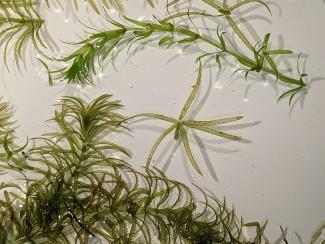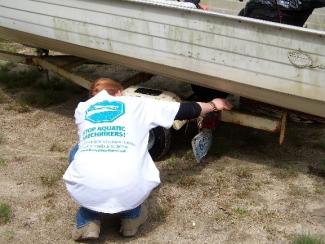DEM Announces RI's First Detection of Aquatic Invasive Plant Hydrilla in Indian Lake, South Kingstown
Published on Friday, September 08, 2023
PROVIDENCE, RI – The Rhode Island Department of Environmental Management (DEM) announces that the highly aggressive invasive plant, Hydrilla verticillata, has been found for the first time in Rhode Island, in Indian Lake in South Kingstown. As part of DEM’s annual monitoring program to identify invasive plants throughout RI, hydrilla was found during an Aug. 9 survey of the lake. Hydrilla is referred to as “the perfect aquatic weed” because it is difficult to manage – having several successful modes of reproduction, tolerating a wide range of pH, salinity, and light conditions, and a rapid, aggressive growth rate. According to U.S. Army Corps of Engineers research, during the first week of growth hydrilla can grow almost three inches per day, but by the fifth week it can grow 191 inches per day due to exponential branching.
Hydrilla in the nearby Connecticut River has taken over 1000 acres of the river, crowding out boaters and anglers who can no longer access boats and docks due to the overgrowth of weeds. Control costs are expensive and hydrilla causes significant economic and ecological damage across the US. The plant easily multiplies from small plant fragments and is quickly spread when contaminated boats travel to new waterbodies. DEM is emphasizing that boaters should take responsibility to check and clean their boats and gear before and after launching their watercraft in any waterbody.
Aquatic weed infestation is a nuisance to anglers, boaters, and swimmers and can affect proper management of freshwater ponds for wildlife. To help control the spread of invasive species, the use of external felt-soled or any natural or synthetic porous material capable of absorbing water in any freshwaters in Rhode Island is strictly prohibited. This includes any waters shared with adjacent states in which Rhode Island fishing regulations apply. The transport of any plant or plant part into or out of any Rhode Island waterbody on boats, vessels, other water conveyances, vehicles, trailers, fishing supplies, or any other equipment is also prohibited. It is recommended that all boaters thoroughly clean their vessels and equipment of attached weeds before and after using the freshwaters of the state. For more information on preventing the spread of aquatic invasive species, click here.
Aquatic invasive plants are one of the largest causes of impairment in freshwater lakes in RI. Currently there are over 110 lakes and ponds in the state with at least one species of invasive plant, and at least one invasive plant type has been recorded in 28 river segments. DEM has documented 14 other different aquatic invasive plant species, the most common being variable milfoil and fanwort. While only these two species are widespread in the state, most of the 15 species are only found in a handful of lakes and boaters must prevent moving these plants on boats and trailers to avoid their spread to new locations. Boaters should check their boat, trailer, motor, lines and other gear for plants, and remove any plant material before traveling. Do not put any plant material removed from vessels into any waterbody but instead dispose of all plants in the trash or compost far from the water. Before heading to a waterbody, boaters should check if invasive plants have been documented at that location using either DEM’s static map and list of waterbodies by town available online here, or the interactive map on DEM’s environmental resource map under the “Freshwater Aquatic Invasive Plants” layer. Boaters are encouraged to report suspected findings of hydrilla by emailing photos and location details to katie.degoosh@dem.ri.gov. Resources to identify the fragile plant can be found here.
Aquatic invasive plants can outcompete native plant species and upset the healthy balance of plants and animals. These aggressive plants change fish and wildlife habitats, disrupt local food webs and may degrade water quality. Large patches of plants can interfere with recreational activities, making boating, swimming and fishing difficult in these areas. The most efficient and cost-effective management strategy is to prevent the plants from moving to, and becoming established in a waterbody, and clean boats are a first line of defense. A 2013 study in Rhode Island found up to 38% of boats observed at a freshwater ramp had some type of vegetation attached. Boaters are encouraged to stop aquatic hitch hikers by following the CLEAN DRAIN DRY approach described below, and can take a pledge online to help protect the waterbodies where they recreate by taking the following actions:
- CLEAN: Remove all visible aquatic plants, animals, and mud from all equipment before leaving water access.
- DRAIN motor, bilge, livewell, and other water containing devices before leaving water access.
- DRY everything for at least 24 hours OR wipe with a towel before reuse.
- DISPOSE of unwanted bait, worms, and fish parts in the trash.
For more information on DEM programs and initiatives, visit www.dem.ri.gov. Follow DEM on Facebook, Twitter (@RhodeIslandDEM), or Instagram (@rhodeisland.dem) for timely updates.


